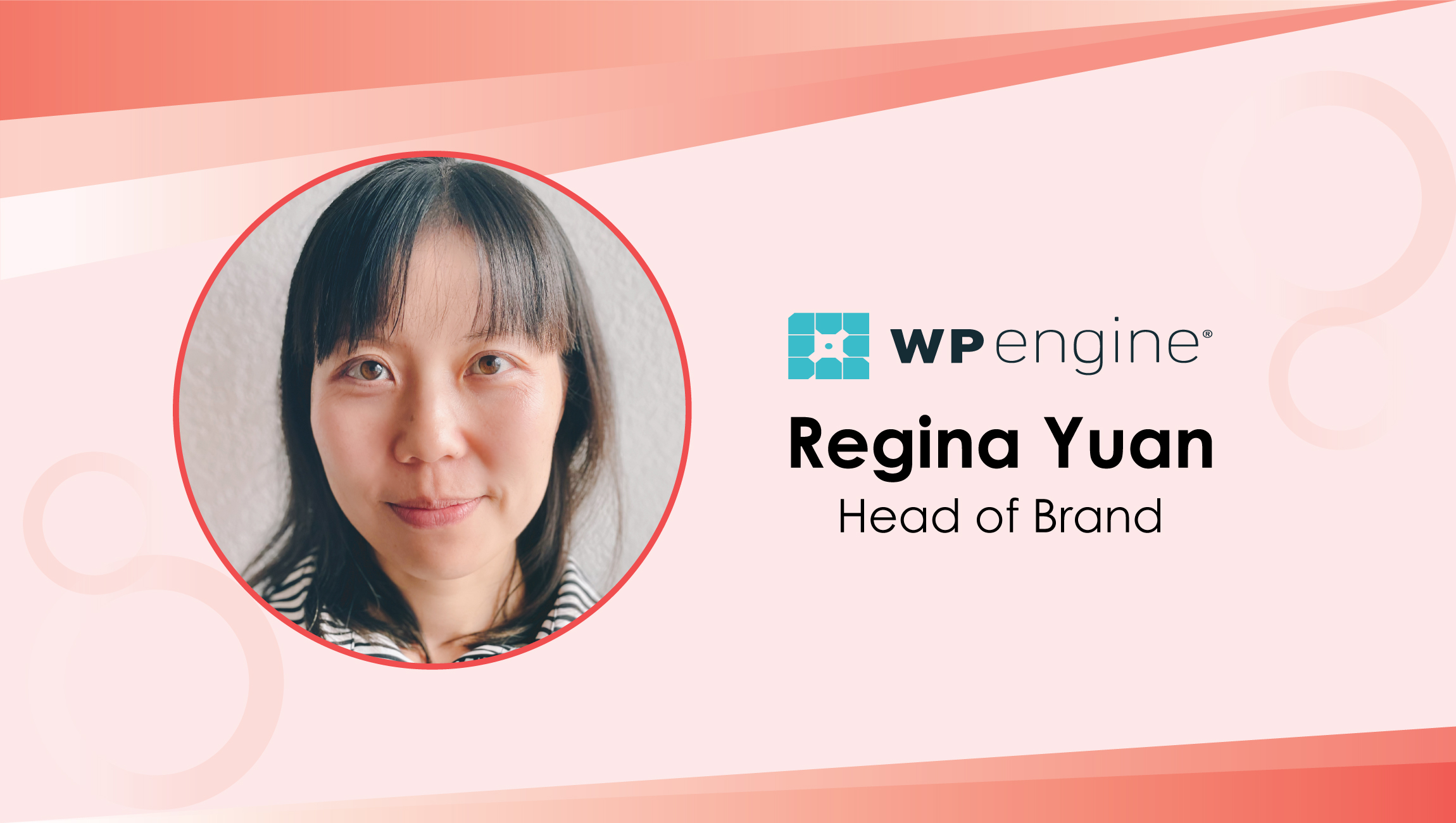Regina Yuan, Head of Brand at WP Engine talks about the impact of rebranding when done right in this catch-up with MarTech Series:
________
Please share a brief introduction to yourself, including your key responsibilities at WP Engine and your background before joining the WP Engine team.
I’m the Head of Brand at WP Engine, where I lead brand strategy, narrative development, creative execution, and performance measurement. I’ve been working in tech marketing for the past 15 years at industry-leading organizations like DocuSign, GoDaddy, CES, National Geographic, and Google China. Since joining WP Engine last May (2023), I’ve helped shape the brand’s identity while driving growth through innovative and impactful brand initiatives — including the newly unveiled rebrand — using my strategic vision, creative and analytical mindset to help position WP Engine as a trusted leader in the web enablement technology space.
Take us through WP Engine’s latest rebrand efforts. What was the need for the change?
Rebranding is a significant undertaking for any company and the decision to do so has to be made for meaningful, strategic reasons — and with great care. For WP Engine, those reasons fell into three big categories: unifying, elevating, and empowering our brand.
Over the years, WP Engine has become a real ‘house of brands,’ with 20-plus brands that build, power, manage, and optimize WordPress sites. However, those brands were never truly unified with WP Engine’s brand identity. That was one of the key goals: We needed to develop and present a clear and unified ‘branded house’ framework, complete with clearly delineated multi-product offerings speaking to multiple audiences with a singular voice.
It’s been over half a decade since our brand style was last updated. The media, customer, and product design use cases had developed beyond the existing visual system, no longer reflecting the brand strategy.
Another key outcome was empowering consistent brand recognition across all platforms and channels. We approached this by creating concise, easy-to-follow brand guidelines that standardized WP Engine’s visual identity and company voice.
In addition to unifying and empowering the brand, we also had to evaluate its market positioning. WP Engine’s brand awareness has remained steady over the last decade, but the market has become increasingly noisy. We needed to elevate our long-standing brand in a way that makes WP Engine stand out among competitors. By communicating our distinct value proposition as a sophisticated, modern company, we’ve positioned ourselves as an industry leader — not a player.
What challenges came with this complete rebrand of their entire group identity and image?
Every rebrand effort takes a village, and the process can have vastly different timelines — taking anywhere from months to years. WP Engine faced challenges both unique and common to companies tackling a project of this size.
Rebranding requires significant resources in terms of time, budget, and labor. As a completely bootstrapped rebrand, we required an ultra-strategic approach to resource allocation to maximize efficiency and effectiveness. Our internal creative team did the vast majority of the work on this project, including strategizing, ideation, operation, and implementation.
We had to implement a number of refinements — from optimizing our brand creative and scrum process to efficiently prioritize, to pooling resources to seeking out cost-effective partners and solutions. Additionally, we continuously measured and adjusted the project plan for performance and resource utilization.
Getting the strategy crystalized and aligned with internal stakeholders was our number one priority. The strategic exploration took months because of the sheer volume of research we did, including more than 80 qualitative interviews and discussions with internal stakeholders and customers to uncover deep and impactful insights. Despite a hefty time commitment, this process made it easy to pursue alignment both internally and externally — which is key for a customer-driven company like WP Engine. Involving employees in this journey also helped the rollout process since their involvement fostered a sense of ownership and commitment to the change.
Streamlining the brand operations process while preserving certain acquired brands’ equity was another obstacle we faced. First, it required us to implement a brand integration decision-making process to rationalize the decision behind each of the acquired brand’s integration path — deciding whether they’d be sunset, integrated, or retained. Second, by designing brand creative treatments for each brand’s pathway, beloved in their own right, we were able to recognize their legacy while making it clear they are part of the WP Engine family.
Marketing Technology News: MarTech Interview with Zhenbin Xu, Chief Product Officer @ Pacvue
What MarTech did you use during this rebrand? Did you use any AI-powered creator tools? If so, could you walk us through how you utilized those?
During the rebranding process, we used a range of tools, which primarily fell into three main categories: research tools, design tools, and project management software.
Most of our qualitative research was conducted through the 80-plus interviews that lasted around an hour each. We leveraged Zoom and Dovetail’s recording capability to summarize high-level notes and integrate learnings.
Our team also experimented extensively with AI-powered design tool snippets and features such as Jasper AI and ChatGPT for copywriting ideation. Additionally, we experimented with Midjourney for image creation—which helped us spin up various options for internal direction alignment early in the process—and relied heavily on Figma and its various plugins for the entire design system buildout and connectivity.
Lastly, we utilized marketing-friendly and handy scrum tools for project management. We transitioned off of Jira and onboarded the entire marketing team to Asana. While not perfect, Asana was an essential tool to maintain a manageable and quantifiable rebrand process.
This project was a major undertaking—ensuring a unified brand image for a group of companies that sport multiple sub brands and services. What tips would you give marketers when trying to accomplish that unification across brands?
Prioritizing the needs and expectations of users and customers is paramount in any brand unification effort. Customers don’t conform to a brand. Instead, they choose a brand that aligns with their preferences and requirements. Therefore, when embarking on the journey to unify our portfolio of brands, it was essential to begin by understanding the perspectives of customers. We engaged with both the product teams and users of each acquired brand during the process and these conversations were instrumental in shaping our approach to designing the creative system. As we listened and learned from our users, our strategy evolved, ensuring that the resulting brand and its new identity resonated authentically with our audience.
Brand management is a delicate balance of art and science, blending creativity with data-driven insights to craft compelling narratives that resonate with customers. Creativity fuels the development of a brand story that connects with audiences on an emotional level — while strategic thinking, informed by data, guides decision-making at every stage of the branding journey. During this rebrand at WP Engine, we harmonized these elements allowing us to effectively communicate our values, mission, and unique selling propositions to our target audience.
Can you list five rebranding mistakes you’d tell everyone in branding and marketing to avoid?
Lacking consistency across brand touchpoints: Brand identity is an umbrella term that spans across brand messaging, visual identity, customer experiences and beyond. Inconsistencies in the planning and execution of a holistic brand identity change would lead to failure. It’s crucial to maintain consistency across all brand touchpoints in a unification process. For WP Engine, we only completed the first step in this process—unveiling our framework and design system—but our journey for the brand transformation is just beginning.
Lack of a clear strategy: Marketers must maintain a brand portfolio strategy and understand how it fits or evolves the existing brand architecture, positioning, and blueprint. In most cases, brand unification requires a portfolio strategy that triggers discussion, addition, or evolution of the general corporate brand strategy.
Rushing the process: Brand unification is a complex and multifaceted endeavor that requires careful planning, execution, and evaluation. Rushing through the process can lead to oversights, errors, and missed opportunities to create a meaningful, impactful brand transformation. It can often also trigger risks on customer churns.
Equating rebranding as simply a creative exercise: ‘Design Matters’ is a core value at WP Engine, and it means that we put care and thought into everything we build, showing we value quality and detail. However, in the world of brand management, creativity does not necessarily lead the way. Typical brand management includes multi-facet steps. Roughly speaking, it includes market research, customer insights, brand strategy and positioning, creative expression, customer experience, and measurement optimization. Equating a rebrand simply as a ‘creative exercise’ will result in a look and feel that doesn’t withstand scrutiny, adoption, and business expansion.
Hesitating to make a decision: One of the common pitfalls of brand unification is going back and forth on a brand’s fate or ‘starving’ its presence until it naturally fades into obscurity. While business or financial considerations may influence such decisions, it’s the brand strategist’s responsibility to help guide a better decision-making process, assess the risk of disruption, and hold the narrative consistent and communicative. By adopting a decisive yet humane approach, brand strategists can steer the brand unification process toward a more impactful outcome.
Marketing Technology News: 10 Benefits of Content Syndication Programs
WP Engine provides the most relied-upon and trusted WordPress products for businesses, brands, and agencies of all sizes.
Regina Yuan, is Head of Brand at WP Engine











